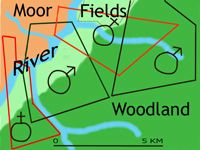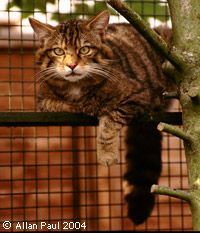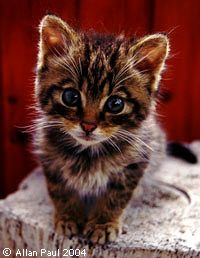
The Scottish wildcat (Felis silvestris grampia)By Allan Paul, June 2004Classification | |
 |
Persecution and habitat loss since the Iron Age has gradually taken its toll on the wildcat, slowly retreating north through mainland Britain, so that by the late 1800's it was only found in Scotland. The advent of Sporting Estates saw wildcats being ruthlessly exterminated as vermin, as the species sometimes preyed on game-birds such as grouse, literally eating into the estates potential profit. The Victorian's lust for spectacular museum specimens also took a toll - gamekeepers were paid a bounty to kill the biggest and fiercest-looking wildcats, which precipitated a loss of the 'large' gene in subsequent generations. A parallel can be found in African elephants, where the 'tuskers' of old, sometimes produced tusks weighing 200 pounds, but were prized (and killed) by big-game hunters, reducing the giant's genetic input to the wild population. Today a tusk weighing 100 pounds is rare. By 1914 the species was almost extinct, save for small, isolated populations, mainly in northwest Scotland, but then was saved by a last-minute reprieve - over 20,000 gamekeepers were called up to fight in the Great War. Around 5000 found re-employment as gamekeepers after the war, similar to modern numbers. Since then wildcats seem to have made a steady recovery, albeit within a limited gene-pool, but the increase in numbers may be due to hybridisation. Many detractors of the modern Scottish wildcat point out that there has been 2000 years of possible hybridisation since the Romans first introduced the domestic cat, therefore all wildcats today are probably hybrids. Medieval chroniclers, however, recorded that domestic cats were quite scarce in Britain, even in large cities, whereas the 'cat of the forest', i.e. the wildcat, was still very common. Hybridisation is much more likely to have become a problem since WW2, when the domestic cat population began to increase explosively. It is thought there may be 7,500,000 domestic cats in Britain today, but only perhaps 400 pure wildcats living wild in Scotland, according to the latest figures from the National Museums of Scotland, so the chances of a pure Scottish wildcat meeting another for reproduction is extremely unlikely. The small gene-pool, post WW1, has also made the species more susceptible to all the diseases carried by domestic cats, e.g. the so called 'cat flu' is known to have wiped out an entire local population of wildcats near Pitlochry in the 1990's. |
 |
Some measure of legal protection was at last given to the wildcat by the inclusion of the species in Schedule 5 of the Wildlife and Countryside Act of 1988,
making it an offence to take from the wild, injure or kill a wildcat. This law was shown to be toothless, however, when in 1991 a Stonehaven court found a
farmer not guilty of killing three wildcats when an expert witness failed to positively identify the animals as wildcats. And the killing goes on - this fine specimen was found near some pheasant-feeding ground on Atholl Estate, Perthshire, last year. The finder contacted me, as studbook keeper, as he was unsure what to do about it, so I asked him to report the incident as a wildlife crime to his local Wildlife Crime Liaison Officer. He did so, but the officer told him it was a domestic cat, so no crime had been committed. It took the combined identification of the wildcat by Dr Andrew Kitchener, Curator Birds and Mammals, National Museums of Scotland, Professor Russell Coope, another wildcat expert, and myself, before the officer logged the crime. I told the finder to secure the wildcat as evidence, but by the time he got there it was gone, another very important, perhaps crucial contributor to the local wild gene-pool lost forever. |
Territory and Behaviour |
A typical territory for a wildcat is generally thought to be around 2 square kilometres, but this depends on factors like local wildcat population numbers and prey density. Wildcats seem to select territories covering differing habitat types, increasingthe chances of survival and perhaps exploiting seasonal prey opportunities. A typical territory might include woodland for shelter and prey, including small forest mammals and birds, rivers and streams for frogs, the fringes of agricultural land for rabbits, and some moorland for hare, grouse etc. Wildcats are solitary creatures, and male's territories tend not to overlap, to lessen the risks of potentially fatal disputes, but may encompass several females, heightening the chances of meetings during the female's oestrus period, usually from January to March. |
 |
Modern commercial forests have little to offer wildcats, as the closed canopy cuts off light, limiting the amount of vegetation on the forest floor, affecting the grazing of small herbivorous mammals which in turn may become wildcat prey. A stream flows in a gorge on the left of the image, with steep sides making human locomotion difficult, keeping the area relatively free from disturbance. Overgrown glacial boulders and rocks in the centre of the image provide plenty of potential den spaces. |
 |
Wildcat droppings, or scat (left), is black, or dark brownish-green when fresh, becoming a dry, light green-grey with age, and is usually made up of 3 or 4 segments, sometimes held together by strands of hair. The scat usually contains bone fragments, fur, and as in this case, ingested grass, an instinctive behaviour intended to cure worms. Scat is usually buried inside the territory, but left exposed on the periphery, usually in prominent places like the middle of paths, on rocks or fallen logs. This acts as a visual and olfactory advert, from which the intruding cat can gauge how new the scat is, and the gender, age, and stage of the reproductive cycle of the owner of the territory. |
 |
This is Ailsa, one of the hybrid wildcats in our care, rubbing her cheek against a tree. Cheek glands impart a scent on trees, overhanging branches, blades of grass, etc, at just the right height for another wildcat to smell. All our domestic cats and kittens we have cared for over the years have behaved in exactly the same manner, but none have left a scent the human nose can discriminate. Wildcat kittens, hand-reared in our home, often rubbed their cheeks on our furniture, plants, and us, but in comparison this scent became extremely pungent, offensive, and clinging. This demonstrates just one marked difference between domestic cats andwildcats which remains almost intangible. |
 |
Wildcats also scent-mark their territory by scratching. Raking their claws across tree stumps, fence posts etc, not only 'sharpens' their claws by removing the old, blunt outer sheath, revealing a new sharp claw underneath, but interdigital glands impart a scent on the claws, sending the smell deep into the wood, as a longer-lasting marker. Our captive wildcats have also demonstrated another means of advertising their presence, by urinating and defecating in their drinking water supply. This, to my knowledge, has never been documented before, but wild-living wildcats may release waste products over ponds, rivers and streams on theirterritory, scattering their scent over a much larger area, alerting prospective mates to try harder in their search. |
 |
Common with all cats, the wildcat has an extremely rough tongue, which it uses to lick and rasp flesh from the pelt and bones. Larger portions are excised with the scissor-like carnassial teeth. These remains of a rabbit are fairly typical of a wildcat kill. The pelt has been licked back to reveal the meat, which has been eaten along with smaller bones such as the ribs, front legs and some of the smaller vertebrae, leaving only thefur and a few larger bones. The kidneys, liver, heart and brain are relished, but the intestines and lungs are largely ignored. Pure wildcats usually seek each other out for mating from January to March, with a 65 day gestation period. By comparison, the domestic cat can mate at any time of the year, for a gestation period of 68 days. Wildcat kittens born later in the year, or in a second litter, are symptomatic of hybridisation, and would be unable to survive in the wild during a Scottish winter. Usually three or four kittens are born, and are blind for the first 2 weeks,staying in the den until about a month old, and then venturing out for shortdistances. Their eyes are blue at first, like 7 week old Jake (left), slowly changing to the amber of an adult by around 4 months. Weaning takes place by 2 months old, when the kittens start to accompany their mother on hunting trips further afield, slowly learning from her expertise. The kittens are fully independent from their mothers by 5 months, sexually mature by the time they are one year old, and skeletally mature by 2 years. |
Morphology |
Identifying a pure wildcat is easy, as is identifying a pure domestic cat, but the problem arises in the infinite variety of hybridised cats in between. Dr Andrew Kitchener, Curator at the National Museums of Scotland, described Aelach (left) as one of the best specimens of a pure wildcat seen in recent years. He is now on display at the museum, representing the Scottish wildcat in an exhibition of the 37 species of wild cat, called 'Cats - the Ultimate Predator'. The most noticeable feature here is his very broad head, ears set well to the side, with large cheeks and broad, strong, very coarse white whiskers. Also apparent is his marked body stripes, bushy ringed tail, and small white patch on his chest. His general demeanour was more like a miniature lion than a relative of adomestic cat. He displayed a stubborn self-confident hatred towards us, emitting a steady low growl in our presence, which increased in volume in relation to our closeness, culminating in an incredibly unnerving explosive spit and a loud foot-stamp if he felt threatened. |
 | Pure wildcats have a single dorsal stripe, which ends at the root of the well-ringed tail, and distinct body stripes, which are inclined to be most complete around the chest. A thin, tapering tail, often with complex overlapping rings and an extension from the dorsal stripe down the top of the tail, is a sign of hybridisation with domestic cats, as are white patches other than around the mouth, chest and groin. Other signs of hybridisation include a round face, weak thin whiskers, pale gums and tongue, and body stripes breaking to become spots over the rump. © Allan Paul 2004 |
 |
 |
| Return to index | Return to Scottish wildcat |